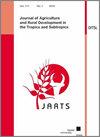萨赫勒条件下珍珠粟种球技术的理化优化
Q3 Social Sciences
Journal of Agriculture and Rural Development in the Tropics and Subtropics
Pub Date : 2018-01-01
DOI:10.17170/KOBRA-2019011596
引用次数: 5
摘要
本文研究了萨赫勒地区旱作播种和珍珠粟种球技术的发展。首先,我们在塞内加尔的参与性评估表明:(1)种子球生产所需的当地材料在当地可获得,(2)该技术符合萨赫勒地区现有的管理系统,(3)社会经济条件不妨碍种子球的采用。然后,对种子球进行机械和化学优化。在温室条件下培养由球变异体衍生的珍珠粟幼苗,并与对照进行比较。结果表明,80 g沙子+ 50 g壤土+ 25 ml水的组合是标准的种球面团,可以产生约10个直径为2 cm的种球。添加1 g氮磷钾或3 g木灰作为营养添加剂均可提高珍珠谷子幼苗早期生物量。铵肥、尿素和阿拉伯胶作为种球成分阻碍了幼苗的出苗。与对照相比,种球+ 3 g木灰处理和种球+ 1 g氮磷钾处理分别使地上部生物量增加60%和75%,根系生物量增加36%和94%,根长密度增加14%和28%。处理对茎部养分含量影响不大。然而,生物量与养分含量的乘积表明,营养改良后的种球养分提取率更高。在塞内加尔进行的现场测试显示,在真实的萨赫勒条件下,95%以上的人出现了这种情况。由于在萨赫勒地区条件下,早苗增强对珍珠粟穗产量起决定性作用,因此建议在萨赫勒地区进行农场试验。本文章由计算机程序翻译,如有差异,请以英文原文为准。
Physical and chemical optimisation of the seedball technology addressing pearl millet under Sahelian conditions
This study deals with the development of the seedball technology in particular for dry sowing under Sahelian conditions and pearl millet as crop. At first, our participatory evaluation in Senegal showed that (i) local materials needed for seedball production are locally available, (ii) the technology conforms to the existing management systems in the Sahel, and (iii) socio-economic conditions do not hinder seedball adoption. Afterwards, seedball was mechanically and chemically optimised. Pearl millet seedlings derived from the seedball variants were grown and compared to the control under greenhouse conditions. Our results showed that the combination of 80 g sand + 50 g loam + 25 ml water is the standard seedball dough, which produces about ten 2 cm diameter-sized seedballs. Either 1 g NPK fertiliser or 3 g wood ash can be added as nutrient additive to enhance early biomass of pearl millet seedlings. Ammonium fertiliser, urea and gum arabic as seedball components hampered seedlings emergence. Seedball + 3 g wood ash and seedball + 1 g NPK-treatments enhanced shoot biomass by 60 % and 75 %, root biomass by 36 % and 94 %, and root length density by 14 % and 28 %, respectively, relative to the control. Shoot nutrient content was not greatly influenced by treatment. However, multiplying biomass yield with nutrient content indicates that nutrient extraction was higher in nutrient-amended seedballs. On-station field tests in Senegal showed over 95 % emergence under real Sahelian conditions. Since early seedlings enhancement is decisive for pearl millet panicle yield under the Sahelian conditions, on-farm trials in the Sahel are recommended.
求助全文
通过发布文献求助,成功后即可免费获取论文全文。
去求助
来源期刊
CiteScore
2.30
自引率
0.00%
发文量
0
审稿时长
>36 weeks
期刊介绍:
The Journal of Agriculture and Rural Development in the Tropics and Subtropics publishes papers dealing with original research and review papers in the fields of plant production, animal nutrition and animal husbandry, soil science, rural economy and farm management, forestry and forest economy, veterinary hygiene and protection against epidemics.

 求助内容:
求助内容: 应助结果提醒方式:
应助结果提醒方式:


